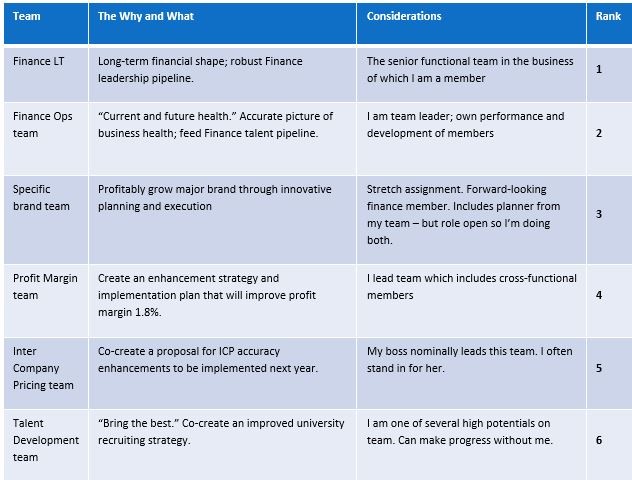When Team Meetings Collide
“Why am I here? I’m not really doing anything except catching up on emails on my phone while others rattle off facts from slide decks that have ZERO to do with me.”
It’s happened to all of us who have worked in large organizations. You’re heads down at your desk working on a significant project when an invitation lands in your inbox. No big deal. You get 10 of these a day. When you reach a convenient stopping point, you open the invitation prepared to click “Accept.” Then you notice that it’s scheduled for the same day and time as another meeting on your calendar. This new invite is for a big meeting with several attendees so you can’t easily propose an alternative time; there are just too many schedules to account for. You think about trying to attend part of both meetings – an hour at this one, 90 minutes at the other - but they’re in different cities so that’s not possible. You just have to say, “no” to one of them. How do you decide?
Your calendar’s collision course: too many team meetings
Several years ago I did an informal study that suggested that the typical manager at Mars, Inc, where I worked, was on 6+ different teams. These included the team they led, the one led by their boss, plus special project teams, steering teams, advisory councils, planning committees and the like. It’s the same for many of you. All of the groups you’re a part of have meetings to get some part of their work done. Invariably, from time to time, some of these meetings will conflict with each other. Usually, we go with our gut in these situations; choose the meeting that seems most important (or most fun), keep that one on your calendar and decline the other one. That works, usually. Except when the person running the meeting you decline thinks that her meeting is more worthy of your time than anything else. Or, when both meetings feel similarly important.
Deciding which meetings to accept and which to decline, like any business decision, should be as rational and fact-based as possible. Not just because it’s common sense. You want to maintain the best possible relationships with everyone you work with. When that manager who is ticked at you for declining her meeting comes calling, you want to be able to offer sound reasons why you chose the way you did. That’s where my core belief about collaboration comes in:
To collaborate better, collaborate less on what matters most.
It begins with figuring out what matters most. The approach I recommend is rooted in the same thinking that is at the heart of all my work with teams: clarify the compelling “Why” and the “What” of the teams you’re a part of. [For more on the Why and What, see my HBR.com Article - Stop Wasting Money on Team Building]
Let’s be real: not all teams or groups are created equal. Sure, every team you’re on at work was created to get something useful done. But when it comes to prioritizing how you’ll spend your time, you have to know which ones matter most at that moment. To make trade-off decisions between competing stakeholder groups, you have to understand the relative value and importance of each one. You need clarity about the role each team plays, why it is more (or less) important so you can decide how much of your time you’re prepared to devote to it.
Assess each team’s purpose and value
To make this assessment, you need help from the teams you’re part of. Each team you’re on should know their “Why” and “What,” they should have answered these two questions:
Why is this team a team?
What tasks require the team’s collaboration?
Here’s more on what these two questions are all about:
The Why: The key here is to define how the team’s collaboration creates value beyond the sum of every member’s individual efforts. If a group’s work is simply a collection of individual efforts, it doesn’t need collaboration via meetings; it requires only coordination. A capable manager should be able to coordinate efforts and pull together what’s needed to produce the results with minimal team interaction. If, on the other hand, the work of the team requires real collaboration, if success depends on the group working together to create the best outcome, then there’s value in those meetings.
The What: Even in highly collaborative groups, not all work requires everyone to be involved. Teams need to identify the specific tasks and initiatives that require collaboration, and then decide the degree of collaboration that each needs. Some tasks may need only subsets of the team to work on them. In these cases, the only people who need to meet are those doing the work. Other pieces of work may need the entire team. It’s this category of work, full team collaboration, that justifies having a meeting with everyone in attendance.
You can tell which teams that haven’t clarified their Why and What. You sit in their meetings and wonder, “Why am I here? I’m not really doing anything except catching up on emails on my phone while others rattle off facts from slide decks that have ZERO to do with me.” You aren’t essential but they don’t know that because they don’t have enough Why and What clarity. They just gather everyone one up in a meeting because you’re all on the team and something might come up that you should know about. What a waste of time and energy.
I can almost hear you saying, “But that’s what most of my meetings are like!” Well, then, get together with those teams and help them answer the Why and What questions. When they do, you and all your teammates can use that information to make better decisions about which meetings you really need to attend.
Rank what you’ve discovered about all your teams and prioritize them
In fact, if you can get that Why and What information, you can create a guide for yourself. Make a table that shows the Why and What of each team placing demands on you. Then, rank the teams from top to bottom and assign each a rough percentage of time you believe you can devote to them. That might looks something like this:
(By the way, be sure boss has a say in this ranking exercise; the odds are they will have strong views about how much of your time you spend where.)
With this little guide in hand, you can help those who want your time understand why you are making the choices you are. These conversations won’t be easy and rarely please everyone. One team or another will be disappointed feeling short-changed. But it’s far better to negotiate these uncomfortable trade-offs with clarity about how your time serves which causes and outcomes, and why these matter to you, your boss and the business.
Clarify any new team’s What and Why from the beginning
The next time that invitation lands in your inbox and you have to decide which one of two (or three, or four) conflicting meetings to attend, remember: collaborate better by collaborating less on the things that matter most. Think about the Why and the What of each meeting and team. If you aren’t clear, go create some clarity even if you have to do it on your own. If you can get your teams involved in figuring out the Why and the What all the better for them, for you and for the larger organization. The more we understand what value a meeting is meant to create, and which work actually requires collaborative effort, the better we can allocate our most valuable resources – our time, energy and enthusiasm. That’s good for everyone.
Carlos Valdes-Dapena is the Managing Principal of Corporate Collaboration Resources and the author of Lessons from Mars: How One Global Company Cracked the Code on High Performance Collaboration and Teamwork



